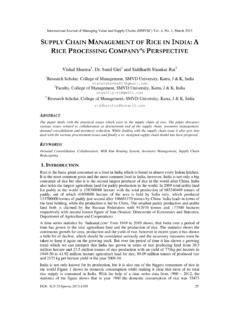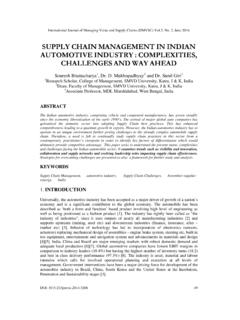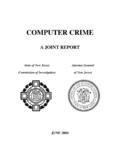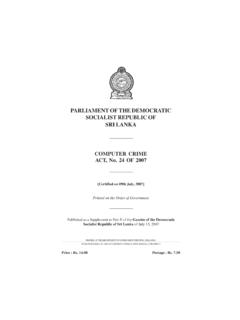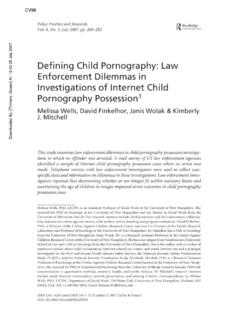Transcription of International Journal of Computer Science & …
1 International Journal of Computer Science & Information Technology (IJCSIT), Vol 3, No 3, June 2011 DOI : 17 COMMON PHASES OF Computer FORENSICS investigation MODELS Yunus Yusoff, Roslan Ismail and Zainuddin Hassan College of Information Technology, Universiti Tenaga Nasional, Selangor, Malaysia ABSTRACT The increasing criminal activities using digital information as the means or targets warrant for a structured manner in dealing with them. Since 1984 when a formalized process been introduced, a great number of new and improved Computer forensic investigation processes have been developed.
2 In this paper, we reviewed a few selected investigation processes that have been produced throughout the years and then identified the commonly shared processes. Hopefully, with the identification of the commonly shard process, it would make it easier for the new users to understand the processes and also to serve as the basic underlying concept for the development of a new set of processes. Based on the commonly shared processes, we proposed a generic Computer forensics investigation model, known as GCFIM. KEYWORDS Computer Forensic Models, Computer Forensic investigation 1. INTRODUCTION The increasing criminal activities using digital information as the means or targets warrant for a structured manner in dealing with them.
3 As more information is stored in digital form, it is very likely that the evidence needed to prosecute the criminals is also in digital form. As early as 1984, the FBI Laboratory and other law enforcement agencies began developing programs to examine Computer evidence [1]. The process or procedure adopted in performing the Computer forensic investigation has a direct influence to the outcome of the investigation . Choosing the inappropriate investigative processes may lead to incomplete or missing evidence. Bypassing one step or switching any of the steps may lead to inconclusive results; therefore give rise to invalid conclusions. Evidences captured in an ad hoc or unstructured manner may risks of not being admissible in the court of law.
4 It is indeed very crucial for the Computer forensics investigator to conduct their work properly as all of their actions are subjected to scrutiny by the judiciary should the case be presented in the court. The presence of a standard structured process does in a way provide a suitable mechanism to be followed by the Computer forensic investigators. Over the years, there were a number of investigation models being proposed by various authors. Based on our observation, some of the models tend to be applicable to a very specific scenario while other may be applied to a wider scope. Some of the models tend to be quite detail and others may be too general. It may be a bit difficult or even confusing, especially to the junior forensic investigator to adopt the correct or appropriate investigation model.
5 It is of our intention to analyse the various available models and extract the common phases and propose a International Journal of Computer Science & Information Technology (IJCSIT), Vol 3, No 3, June 2011 18 new general purpose model so that we can have a common starting model that would be applicable to any scenarios. Terminologies In the course of performing the reviews, we have discovered that different terms were used by various authors, in order to reflect the processes taken to perform the proposed investigation . Among the terms used were model, procedure, process, phase, tasks, etc. In order not to be drawn into a lengthy discussion as to which terms is best to be used, we choose to still maintain whatever terms used by the original authors, when describing their respective processes.
6 However, when conducting comparison and indentifying common characteristics, we need to use one term only (for the purpose of standardization) and chose the term model to represent the entire activities performed in a Computer forensic investigation . The term phase is used to represent the high level component of the investigation model and the term tasks is used to represent activities to be performed in each of the phases. 2. investigation PROCESS REVIEWED The number of suggested and proposed investigation models is not small, as such, it would be quite a daunting exercise to review them all. We have indeed, selected the models to be reviewed based on the chronological order, ensuring at least one proposed model per year.
7 We are not suggesting that the selected models are better or superior than the other models that were also introduced in the same year. Our objective is to identify and extract the phases in the investigation models rather than selecting which model is the best. Computer Forensic Investigative Process (1984) Pollitt [2] [3] has proposed a methodology for dealing with digital evidence investigation so that the results with be scientifically reliable and legally acceptable. It comprises of 4 distinct phases. Figure 1: Computer Forensic Investigative Process In Acquisition phase, evidence was acquired in acceptable manner with proper approval from authority. It is followed by Identification phase whereby the tasks to identify the digital components from the acquired evidence and converting it to the format understood by human.
8 The Evaluation phase comprise of the task to determine whether the components indentified in the previous phase, is indeed relevant to the case being investigated and can be considered as a legitimate evidence. In the final phase, Admission, the acquired & extracted evidence is presented in the court of law. DFRWS Investigative Model (2001) In 2001, the 1st Digital Forensics Research Workshop (DFRWS) [4] proposed a general purpose digital forensics investigation process. It comprises of 6 phases. Acquisition Identification Evaluation Admission International Journal of Computer Science & Information Technology (IJCSIT), Vol 3, No 3, June 2011 19 Figure2: DFRWS Investigative Model DFRWS Investigative model started with an Identification phase, in which profile detection, system monitoring, audit analysis, etc, were performed.
9 It is immediately followed by Preservation phase, involving tasks such as setting up a proper case management and ensuring an acceptable chain of custody. This phase is crucial so as to ensure that the data collected is free from contamination. The next phase is known as Collection, in which relevant data are being collected based on the approved methods utilizing various recovery techniques. Following this phase are two crucial phases, namely, Examination phase and Analysis phase. In these two phases, tasks such as evidence tracing, evidence validation, recovery of hidden/encrypted data, data mining, timeline, etc, were performed. The last phase is Presentation. Tasks related to this phase are documentation, expert testimony, etc.
10 Abstract Digital Forensics Model (ADFM) (2002) Inspired by DFRWS investigative model, Reith, Carr & Gunsch [5], proposed an enhanced model known as Abstract Digital Forensic Model. In this model, the author introduced three additional phases, thus expanding the number of phases to nine. Figure 3: Abstract Digital Forensics Model Identification Preparation Approach Strategy Preservation Collection Examination Analysis Presentation Returning Evidence Identification Preservation Collection Examination Analysis Presentation International Journal of Computer Science & Information Technology (IJCSIT), Vol 3, No 3, June 2011 20 The 3 significant phases introduced in this model were Preparation, Approach Strategy and Returning Evidence.

